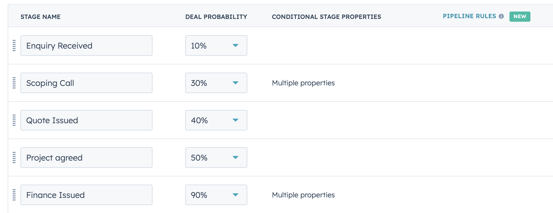


Navigating Through 5 Sales Productivity Pitfalls




Sales productivity serves as the pivot point for a company's success, especially when it comes to effectively leveraging RevOps. Yet, sales teams often face a myriad of challenges that hinder productivity and reduce efficiency. These obstacles can range from misaligned strategies and priorities to inadequate technology, tools, and inefficient processes. This blog aims to uncover inefficiencies in your sales process, addressing five key sales productivity pitfalls. By understanding these common traps, businesses can implement effective strategies to optimise their sales operations, standardise sales team performance, make the most of RevOps, and ultimately achieve better results.
1. Sales Tools: Boon or Bane?
When we think "tools", we often equate them with efficiency, right? Unfortunately, it's not always the case for sales teams. Sales representatives spend a significant proportion of their time navigating through multiple sales tools, often leading to "tool fatigue".
The impact? A significant drop in productivity. A rep tangled in the web of tools is a rep not closing deals, not nurturing client relationships, and not driving revenue growth. Client interactions can suffer too. A customer doesn't care about the number of tools you use. They want quick responses, efficient service, and a personal touch. If reps are too preoccupied with tools, where's the time for the client?
To turn this bane into boon and effectively use sales tools, here are a few strategies you can use:
a. Streamlining tool usage
By identifying and consolidating the most effective and frequently used tools, companies can eliminate unnecessary tools that may be causing more harm than good. This reduces the complexity faced by sales reps, allowing more time to be dedicated to closing deals and nurturing customer relationships.
b. Training on efficient tool navigation
By equipping reps with the skills to quickly navigate through the necessary tools, companies can enhance productivity. Such training should not be a one-off event; it should be a continuous process, updating reps as tools evolve and new ones are introduced.
c. Implementing time-management strategies
If sales reps can effectively allocate their time between tool usage and customer interactions, the potential for inefficiency significantly reduces. Strategies such as time blocking, where specific time slots are dedicated to handling tools and others to customer interactions, can ensure reps are not overwhelmed with simultaneous tasks.
2. Pipeline Mismanagement
Another potential pitfall in sales productivity centres on pipeline management, specifically the timing of advancing customers to the next stage.
When sellers fail to understand when to advance a customer to the next stage in the pipeline, one of two things may happen. Firstly, advancing too quickly can make the customer feel pressured or rushed, leading to a poor customer experience and potentially losing the sale. Conversely, if a customer is not advanced promptly when ready, it could signal a lack of progress and potentially result in lost opportunities as the customer may feel undervalued or neglected.
Furthermore, inaccurate pipeline management can lead to forecasting errors and skewed sales data, which in turn, can cause strategic missteps, resulting in an inefficient allocation of resources. This lack of clarity can create a ripple effect across the RevOps framework, leading to a fall in overall sales productivity.
By following the steps below can help sales teams improve their pipeline management better:
a. Establishing clear pipeline stage criteria
This clarity can avoid premature or tardy stage advancements, ensuring the customer journey is smooth and tailored to their readiness level. Moreover, this strategy also aids in accurate forecasting and data collection.

b. Providing ongoing training and communication
Regular training sessions aimed at refreshing the sales team's understanding of pipeline stages and their criteria can be invaluable. These sessions can reinforce the importance of effective pipeline management and clarify any doubts or misunderstandings, ensuring that all members are on the same page.
c. Implementing milestone-based assessments
Regular assessments based on milestones can help identify any hiccups in the pipeline management process. These checks serve two primary purposes: firstly, they allow for real-time correction of any missteps, preventing the accumulation of errors and their potential impact on sales productivity. Secondly, they provide opportunities for learning and improvement, helping to refine the sales process over time.
3. Delayed Quote Approvals
Speed often determines the winner, delayed quote approvals can, therefore, pose significant challenges, impacting sales efficiency and productivity. The need to secure multiple approvals through hierarchical chains can lead to prolonged waiting times, reducing the sales team's agility and response speed. When reps are left waiting for quote approvals, they are unable to progress deals, which causes potential revenue losses at the cost of ineffective sales processes.
The implications of delayed quote approvals extend beyond internal productivity issues. From a customer perspective, delays can lead to dissatisfaction and even lost sales. Today's customers expect swift, seamless interactions. Any delays in providing quotes can be perceived as poor service, causing frustration and potentially leading the customer to explore competitors' offerings. Furthermore, the lack of prompt quote approvals can impact deal closure rates. The longer it takes for a proposal to get approved, the more time the customer has to reconsider, allowing doubts or second thoughts to creep in, and possibly derailing the deal.
To avoid the pitfalls of ineffective sales processes, here are a few tips sales teams should look back at:
a. Streamlining approval workflows
Streamlining involves simplifying the approval chain, reducing the number of people who need to approve quotations, and thereby trimming the amount of time spent waiting for approvals. This could involve designating a single point of contact for approval or establishing a tiered system where only complex or high-value quotes require multiple approvals.
b. Implementing automated approval systems
These systems can automatically generate quotes based on predefined criteria, making the process faster and more accurate. Moreover, they can instantly forward quotes to the appropriate approvers, eliminating the need for manual routing and potential delays. Automation can also help in tracking the status of quote approvals, providing sales reps with real-time updates and minimising uncertainty.

c. Enhancing communication channels between reps and approvers
This could involve implementing a dedicated communication platform or chat function within the quote approval system, allowing for immediate clarification of any issues or questions. Clear, open, and rapid communication can reduce the time spent waiting for responses, making the quote approval process more efficient and aiding in the overall team's smooth operation.
4. Lack of Team Alignment
Sales operations often face the challenge of team misalignment, especially when sellers struggle to gain support for closing deals. Instead of focusing on closing deals, sellers may find themselves dealing with internal coordination, seeking approvals, or trying to gain team support. Such ineffective sales processes not only wastes time and resources but also leads to delayed responses to customers, potentially causing deals to fail.
A lack of team alignment not only affects internal operations but also impacts deal success rates and customer relationships. Inefficient teamwork slows down the sales cycle, frustrating customers and damaging their trust in the company. Ensuring standardise sales team performance strong team alignment is crucial for maintaining customer relationships and achieving sales success within the RevOps framework.
a. Establishing cross-functional collaboration channels
These channels can promote communication and encourage a more unified approach to achieving sales goals. They serve to break down silos between different departments, allowing for a more seamless exchange of ideas and information. This could be facilitated through shared digital platforms where team members can collaborate, share progress updates, and discuss challenges.
b. Conducting regular team alignment meetings
These meetings not only ensure everyone is up-to-date with the latest sales goals and strategies, but also provide an opportunity to discuss any issues, obstacles, or ideas for improvement. By holding these meetings, teams can ensure consistent messaging, streamline efforts, and ensure that everyone is working towards the same objective and standardise sales team performance.
c. Encouraging a culture of shared success
This involves recognising and celebrating team achievements, rather than individual victories. It promotes a sense of fellowship and shared responsibility, fostering an environment where every success is seen as a collective one, and every challenge faced as a collective responsibility.
5. Limited Time for Coaching
Sales managers often juggle multiple responsibilities, from strategising and forecasting to managing everyone's performance. These duties, combined with the fast-paced nature of the sales environment, can result in coaching often falling by the wayside.
Coaching is an integral part of sales team development. However, the time constraints faced by managers often limit the quantity and quality of coaching provided. Without adequate time designated for coaching, it becomes challenging to deliver personalised guidance, address individual strengths and weaknesses, or adapt coaching styles to suit each team member's needs.
On an individual level, sales reps may struggle with unaddressed challenges, leading to a decline in productivity, and morale. From a team perspective, inadequate coaching can hinder the development of consistent best practices, foster misalignment, and inhibit overall team growth.
In an effort to avoid letting this impact sales outcomes, here's what can be done:
Approaches to maximise coaching effectiveness within time constraints are crucial to nurturing sales team's growth and productivity while respecting the busy schedules of sales managers.
a. Prioritising coaching topics based on impact
This requires identifying the competencies or areas that directly influence sales outcomes and focusing coaching efforts there. Prioritising high-impact topics typically involves a mix of product knowledge, selling techniques, and interpersonal skills. By addressing these areas, even in short coaching sessions, teams can realise immediate and tangible improvements in their performance and uncover inefficiencies in your sales processes.
b. Leveraging technology for asynchronous coaching
Technological advancements can be a game-changer for coaching in time-constrained environments. Asynchronous coaching, where guidance is provided through pre-recorded videos, messages, or annotated reviews, allows sales reps to learn at their own pace and revisit content as needed. This approach not only allows for flexibility but also ensures that coaching is available round the clock, thus driving learning efficiency.
c. Implementing peer-to-peer coaching initiatives
This stimulates knowledge sharing and mutual growth, often leading to new perspectives and innovative solutions. It also fosters a collaborative, team-oriented environment, which can significantly improve overall team performance. By promoting peer-to-peer coaching, managers can ensure constant learning and development, even when they are unable to personally provide coaching.








